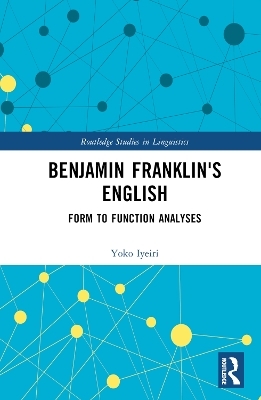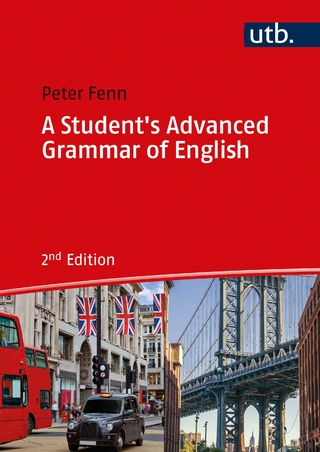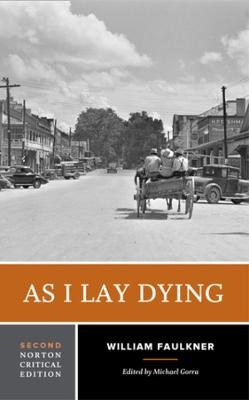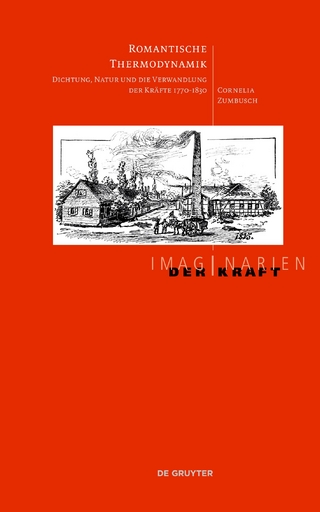
Benjamin Franklin's English
Routledge (Verlag)
978-1-032-27704-2 (ISBN)
- Noch nicht erschienen (ca. Oktober 2024)
- Versandkostenfrei innerhalb Deutschlands
- Auch auf Rechnung
- Verfügbarkeit in der Filiale vor Ort prüfen
- Artikel merken
This book is a fantastic reference for students and scholars of historical linguistics, varieties of English, and World Englishes.
This book delves into Benjamin Franklin’s English, illustrating the variable nature of 18th-century American English and his stylistic manipulation of the potentiality of English. Utilizing corpus methodologies, it offers researchers in historical sociolinguistics unique insights.
Benjamin Franklin is one of the Founding Fathers of the United States and while his achievements have been well established in the history of America, his linguistic activities have been explored only to a lesser extent. Iyeiri examines his letters and autobiography, which provide linguists with opportunities to study his language. The book is structured using the “form-to-function” framework. The first part focuses on different lexical items one by one, and can be read in the order readers want, whilst in the second part, Iyeiri stitches the arguments together, discussing various grammatical features across different lexical items.
This book is a fantastic reference for students and scholars of historical linguistics, varieties of English, and World Englishes.
Yoko Iyeiri is Professor of English Language at Kyoto University. Her research interests are in the history of English. Her publications include Negative Constructions in Middle English (Kyushu UP, 2001) and Verbs of Implicit Negation and their Complements in the History of English (Benjamins, 2010).
Preface and Acknowledgements
List of Tables and Figures
Abbreviations
1. Introduction
1.1. The aim of this study
1.2. Why a single person’s English?
1.3. Form-to-function approach and corpus linguistics
1.4. Benjamin Franklin Corpus and some additional comments
2. Form-to-Function Approach 1: Historical Sociolinguistic Perspectives
2.1. Introductory remarks
2.1.1. General
2.1.2. Negation in the BF Corpus: A case study
2.2. Become
2.2.1. The frequency of become
2.2.2. The perfect of become
2.2.3. Become in the pseudo passive construction
2.3. Behalf
2.3.1. In behalf of vs. on behalf of
2.4. Choose
2.4.1 The conditional use of choose
2.4.2. Some other aspects of choose
2.5. Come
2.5.1. Come and its progressive forms
2.5.2. The perfect of come
2.5.3. Come and its collocation
2.6. Fall
2.6.1. The frequency of the verb fall and its usage
2.6.2. The perfect of fall
2.7. Fear
2.7.1. The frequency of the verb fear and its first-person use
2.7.2. The complementation of the verb fear and its parenthetical use
2.7.3. The noun fear
2.8. Forget
2.8.1. The past participle forms of forget
2.8.2. If I forget not
2.8.3. Forget and its subject
2.8.4. Forget and its complementation
2.9. Go
2.9.1. Go and its progressive forms
2.9.2. The perfect of go
2.9.3. Go and its collocation
2.10. Like
2.10.1. The verb like
2.10.2. Like as a hedge
2.10.3. Like vs. likely
2.11. Methinks
2.11.1. Methinks as a fossilized lexical item
2.12. Please
2.12.1. The pragmatic use of please
2.12.2. Please and its transitivity
2.13. Pray
2.13.1. The pragmatic use of pray
2.13.2. The verb pray followed by that-clauses and to-infinitives
2.14. Remember
2.14.1. Remember and its collocation
2.14.2. Discoursal nature of remember
2.14.3. Remember and its complementation
2.15. Show
2.15.1. Show vs. Shew
2.15.2. Show and the double-object construction
2.16. Think
2.16.1. Think and the first and second persons
2.16.2. The comment clause I think
2.17. Work
2.17.1. The preterite and past participle forms of work
2.18. Write
2.18.1. The preterite and past participle forms of write
2.18.2. I wrote a few lines to you, or the dative object construction
3. Form-to-Function Approach 2: Synchronic and Diachronic Perspectives
3.1. Introductory remarks
3.2. Arrive
3.2.1. The perfect of arrive
3.2.2. Arrive and adverbs
3.3. Avoid
3.3.1. Avoid -ing
3.4. Dare
3.4.1. The status of dare and its use in comment clauses
3.5. Doubt
3.5.1. The verb doubt and its complementation
3.5.2. The noun doubt and its complementation
3.5.3. Doubt and author orientation
3.6. Drink
3.6.1. Drank and drunk
3.6.2. Drink and its objects
3.7. Exceedingly
3.7.1. Exceeding vs. exceedingly
3.8. Forbear
3.8.1. Forbear and its complementation
3.9. Forbid
3.9.1. The past participle forms of forbid
3.9.2. Forbid and its complementation
3.10. Grow
3.10.1. Grow and some syntactic features
3.10.2. Grow with animate and inanimate subjects
3.11. Help
3.11.1. Help and its complementation
3.11.2. Cannot help -ing
3.12. Need
3.12.1. The status of need
3.12.2. Other related expressions
3.13. Return
3.13.1. The perfect of return
3.13.2. The verb return and adverbs
3.14. Scarce
3.14.1. Scarce vs. scarcely
3.14.2. Scarce, scarcely and their collocation
3.15. Speak
3.15.1. The past participle forms of speak
3.15.2. Bespeak, an etymologically related verb
3.16. Street
3.16.1. In the street vs. on the street
3.17. Suffer
3.17.1. Transitive and intransitive uses of suffer
3.17.2. Suffer plus to-infinitive
4. Discussion and Conclusion
4.1. About this chapter
4.2 Discussion from functional perspectives
4.2.1. Morphological and orthographic variation
4.2.2. Auxiliaries vs. lexical verbs
4.2.3. Progressive forms
4.2.4. Be-perfect vs. have-perfect
4.2.5. Passive
4.2.6. The double-object construction
4.2.7. Complementation
4.2.8. Adverbs
4.2.9. Choice of prepositions
4.2.10. Comment clauses and author orientation
4.2.11. Politeness expressions and others
4.3. Concluding remarks
4.3.1. Benjamin Franklin’s English
4.3.2. On the form-to-function approach
References
Electronic resources
Bibliography
Appendix
List of Letters
Index
| Erscheint lt. Verlag | 24.10.2024 |
|---|---|
| Reihe/Serie | Routledge Studies in Linguistics |
| Zusatzinfo | 58 Tables, black and white; 6 Line drawings, black and white; 6 Illustrations, black and white |
| Verlagsort | London |
| Sprache | englisch |
| Maße | 156 x 234 mm |
| Themenwelt | Geisteswissenschaften ► Sprach- / Literaturwissenschaft ► Anglistik / Amerikanistik |
| Geisteswissenschaften ► Sprach- / Literaturwissenschaft ► Literaturwissenschaft | |
| Geisteswissenschaften ► Sprach- / Literaturwissenschaft ► Sprachwissenschaft | |
| ISBN-10 | 1-032-27704-1 / 1032277041 |
| ISBN-13 | 978-1-032-27704-2 / 9781032277042 |
| Zustand | Neuware |
| Haben Sie eine Frage zum Produkt? |
aus dem Bereich


